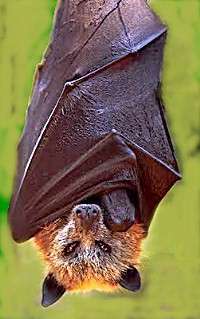Yinpterochiroptera
The Yinpterochiroptera (or Pteropodiformes) is a suborder of the Chiroptera, which includes taxa formerly known as megabats and five of the microbat families: Rhinopomatidae, Rhinolophidae, Hipposideridae, Craseonycteridae, and Megadermatidae. This suborder is primarily based on molecular genetics data. This proposal challenged the traditional view that megabats and microbats form monophyletic groups of bats. Further studies are being conducted, using both molecular and morphological cladistic methodology, to assess its merit.[1]
| Yinpterochiroptera | |
|---|---|
 | |
| Scientific classification | |
| Kingdom: | Animalia |
| Phylum: | Chordata |
| Class: | Mammalia |
| Order: | Chiroptera |
| Suborder: | Yinpterochiroptera Springer, Teeling, Madsen, Stanhope and Jong, 2001 |
| Families | |
|
Craseonycteridae | |
The term Yinpterochiroptera is constructed from the words Pteropodidae (the family of megabats) and Yinochiroptera (a term proposed in 1984 by Karl F. Koopman to refer to certain families of microbats[2]). Recent studies using transcriptome data have found strong support for the Yinpterochiroptera-Yangochiroptera classification system.[3] Researchers have created a relaxed molecular clock that estimates the divergence between Yinpterochiroptera and Yangochiroptera around 63 million years ago. The most recent common ancestor of Yinpterochiroptera, corresponding to the split between Rhinolophoidea and Pteropodidae (Old World Fruit bats), is estimated to have occurred 60 million years ago.[4]
The first appearance of the term Yinpterochiroptera was in 2001, in an article by Mark Springer and colleagues.[5] As an alternative to the subordinal names Yinpterochiroptera and Yangochiroptera, some researchers use the terms Pteropodiformes and Vespertilioniformes, basing the names on the oldest valid genus description in each group, Pteropus and Vespertilio.[2][6] Under this new proposed nomenclature, Pteropodiformes is the suborder that would replace Yinpterochiroptera.
Classification
Suborder Yinpterochiroptera (Pteropodiformes)
- Family Craseonycteridae (Kitti's hog-nosed bat)
- Family Hipposideridae (Old World leaf-nosed bats)
- Family Megadermatidae (false vampires)
- Family Pteropodidae (megabats)
- Family Rhinolophidae (horseshoe bats)
- Family Rhinopomatidae (mouse-tailed bats)
References
- "Order Chiroptera bats". animaldiversity.ummz.umich.edu. Retrieved 2007-12-30.
- James M. Hutcheon and John A.W. Kirsch (2006). "A moveable face: deconstructing the Microchiroptera and a new classification of extant bats" (PDF). Acta Chiropterologica. 8: 1–10. doi:10.3161/1733-5329(2006)8[1:AMFDTM]2.0.CO;2.
- Tsagkogeorga, Georgia; Parker, Joe; Stupka, Elia; Cotton, James A.; Rossiter, Stephen J. (2013). "Phylogenomic Analyses Elucidate the Evolutionary Relationships of Bats". Current Biology. 23 (22): 2262–2267. doi:10.1016/j.cub.2013.09.014. ISSN 0960-9822. PMID 24184098.
- Lei, M; Dong, D (2016). "Phylogenomic analyses of bat subordinal relationships based on transcriptome data". Scientific Reports. 6: 27726. doi:10.1038/srep27726. PMC 4904216. PMID 27291671.
- Springer, M. S.; Teeling, E. C.; Madsen, O.; Stanhope, M. J.; de Jong, W. W. (2001). "Integrated fossil and molecular data reconstruct bat echolocation". Proceedings of the National Academy of Sciences. 98 (11): 6241–6246. doi:10.1073/pnas.111551998. ISSN 0027-8424. PMC 33452. PMID 11353869.
The proposed suborder Yinpterochiroptera is based on the conjunction of ‘yin’ and ‘ptero’ to reflect the composition of this new taxon.
- Eick; Jacobs, DS; Matthee, CA; et al. (2005). "A Nuclear DNA Phylogenetic Perspective on the Evolution of Echolocation and Historical Biogeography of Extant Bats (Chiroptera)". Molecular Biology and Evolution. 22 (9): 1869–86. doi:10.1093/molbev/msi180. PMID 15930153.
Following the recommendations of Hutcheon and Kirsch (2004), we refer to the two suborders of chiropterans as ‘Pteropodiformes’ (comprising the Pteropodidae, Rhinolophidae, Hipposideridae, Megadermatidae, and Rhinopomatidae) and ‘Vespertilioniformes’ (remaining microbat families).
- Teeling, E.C.; Springer, M.S.; Madsen, O.; Bates, P.; O'Brien, S.J.; Murphy, W.J. (2005). "A Molecular Phylogeny for Bats Illuminates Biogeography and the Fossil Record". Science. 307 (5709): 580–584. doi:10.1126/science.1105113. PMID 15681385.
- Teeling, E.C.; Scally, M.; Kao, D.J.; Romagnoli, M.L.; Springer, M.S.; Stanhope, M.J. (2000). "Molecular evidence regarding the origin of echolocation and flight in bats". Nature. 403 (6766): 188–192. doi:10.1038/35003188. PMID 10646602.